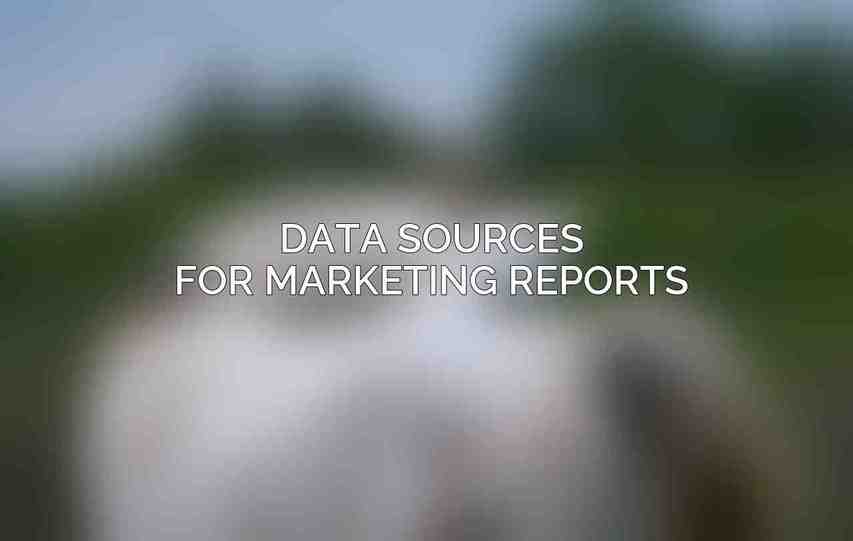The importance of marketing reports cannot be overstated. these reports play a vital role in providing actionable insights for decision-making, tracking progress, measuring return on investment (ROI), and identifying areas for improvement within marketing campaigns.
Selecting the Right Metrics
When setting up marketing reports, it is crucial to focus on Selecting the Right Metrics. Following SMART Goals (Specific, Measurable, Achievable, Relevant, Time-bound) is key to setting meaningful objectives. For instance, goals like increasing website traffic by 10% in 6 months provide a clear direction for marketing efforts. Identifying Key Performance Indicators (KPIs) that are relevant to business objectives, quantifiable, and timely, such as website traffic, conversion rates, and customer lifetime value, helps to measure success effectively.
Data Sources for Marketing Reports

Utilizing diverse Data Sources ensures comprehensive insights in marketing reporting. Leveraging tools like Google Analytics enables tracking website traffic, demographics, and user behavior, allowing for custom report creation and dashboard setup. Google Search Console is vital for monitoring keyword performance, search rankings, and uncovering SEO opportunities. Social media analytics tools offer insights into engagement, reach, and conversion rates across various platforms. Email marketing platforms provide data on open rates, click-through rates, and unsubscribe rates essential for optimizing email campaigns.
Data Visualization Techniques
In presenting marketing data effectively, Data Visualization Techniques play a significant role. Using graphs like line graphs to showcase trends over time, bar graphs to compare values across categories, and pie charts to illustrate proportions can enhance data comprehension. Tables help in presenting structured data in an organized manner, utilizing clear headers to label columns and rows. Dashboards offer comprehensive views of key metrics, allowing for interactive exploration of data.
Reporting Structure and Content
A well-structured Reporting Framework ensures that marketing reports are informative and actionable. Components like an Executive Summary provide a brief overview of key findings and recommendations. Marketing Campaign analyses delve into the performance of specific initiatives, offering insights for future strategies. Channel Analysis evaluates the effectiveness of different marketing channels, while Competitive Analysis compares performance against industry benchmarks, identifying strategic advantages.
Reporting Frequency and Distribution
Determining the Reporting Frequency based on data availability and business needs – be it weekly, monthly, or quarterly – ensures timely insights. When it comes to Distribution, making reports accessible to stakeholders through email, presentations, or online dashboards is essential for transparency and collaboration.
Monitoring and Evaluation
Regular Monitoring and Evaluation of marketing reports is vital to ensure their relevance and accuracy. Continuous Reporting Reviews help in identifying areas for improvement and ensuring that insights remain actionable. Validating data sources and ensuring accuracy through data verification methods minimize errors and discrepancies.
Reporting Tools and Software

Utilizing the right Reporting Tools enhances the efficiency of marketing reporting. Platforms like Google Data Studio offer interactive dashboards and reports, seamlessly integrating with Google Analytics. Power BI is a paid tool known for its advanced data visualization capabilities and suitability for large datasets. Tableau stands out for its storytelling and extensive feature set, making it a popular choice for data visualization and analysis in marketing reporting practices.
By implementing a robust marketing reporting framework that emphasizes the selection of relevant metrics, leveraging diverse data sources, employing effective visualization techniques, structuring reports with clear content, and utilizing appropriate tools, businesses can set themselves up for success in tracking, analyzing, and optimizing their marketing efforts. Find more on Top Marketing Reporting Tools of 2024 Reviewed
Frequently Asked Questions
What are marketing reports?
Marketing reports are documents that provide key performance metrics and insights on the effectiveness of your marketing campaigns and strategies.
What are the benefits of setting up marketing reports?
Setting up marketing reports allows you to track and measure the success of your marketing efforts, identify areas for improvement, and make data-driven decisions to optimize your strategies.
What key metrics should be included in marketing reports?
Key metrics that should be included in marketing reports vary depending on your goals and objectives, but common ones include website traffic, conversion rates, ROI, customer acquisition cost, and customer lifetime value.
How often should marketing reports be reviewed and analyzed?
Marketing reports should be reviewed and analyzed regularly, typically on a weekly or monthly basis, to stay informed about the performance of your marketing activities and make timely adjustments.
What tools can I use to set up and generate marketing reports?
There are many tools available for setting up and generating marketing reports, such as Google Analytics, HubSpot, and Salesforce. Choose a tool that aligns with your reporting needs and integrates well with your existing systems.

